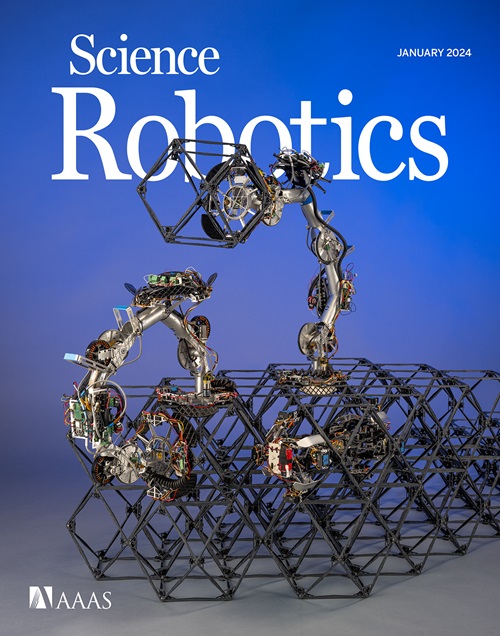Cooperative robotic exploration of a planetary skylight surface and lava cave
IF 27.5
1区 计算机科学
Q1 ROBOTICS
引用次数: 0
Abstract
Exploration of lava caves on the surface of planetary bodies near Earth is of high importance for scientific research and space exploration. The natural shielding that these caves offer against radiation and small meteorites makes them well suited for preserving exobiological signatures and protecting human-made facilities. The use of a robot team arises as the safest and most cost-efficient way to explore extraterrestrial lava caves because they are difficult to access. Although the approach has been demonstrated in similar scenarios on Earth, its adaptation to space conditions needs further research. Here, we define a lava cave exploration mission concept, including four mission phases that are performed by a heterogeneous team of three robots equipped with the required hardware and software. This mission concept was validated in a relevant scenario, a lava cave on Lanzarote island (Spain), where the team of robots was able to build a three-dimensional model of the surrounding area and skylight, introducing a scout rover through rappelling and exploring the inner part of the cave. The results obtained demonstrate the proposed mission concept’s feasibility, including three next-generation planetary exploration rovers that were coordinated to obtain meaningful information about the lava cave’s external and internal morphology.

行星天窗表面和熔岩洞的合作机器人探索
探测近地行星体表面的熔岩洞对科学研究和空间探索具有重要意义。这些洞穴对辐射和小陨石的天然屏蔽使它们非常适合保存外星生物特征和保护人造设施。使用机器人团队是探索外星熔岩洞穴最安全、最具成本效益的方式,因为它们很难进入。虽然这种方法已经在地球上类似的场景中得到了证明,但它对太空条件的适应性还需要进一步的研究。在这里,我们定义了一个熔岩洞穴勘探任务概念,包括四个任务阶段,由三个配备所需硬件和软件的机器人组成的异构团队执行。这个任务概念在一个相关的场景中得到了验证,在兰萨罗特岛(西班牙)的熔岩洞中,机器人团队能够建立周围区域和天窗的三维模型,通过绳索下降引入侦察漫游者并探索洞穴的内部。所获得的结果证明了所提出的任务概念的可行性,包括三个下一代行星探测漫游者,它们相互协调,以获得有关熔岩洞外部和内部形态的有意义的信息。
本文章由计算机程序翻译,如有差异,请以英文原文为准。
求助全文
约1分钟内获得全文
求助全文
来源期刊

Science Robotics
Mathematics-Control and Optimization
CiteScore
30.60
自引率
2.80%
发文量
83
期刊介绍:
Science Robotics publishes original, peer-reviewed, science- or engineering-based research articles that advance the field of robotics. The journal also features editor-commissioned Reviews. An international team of academic editors holds Science Robotics articles to the same high-quality standard that is the hallmark of the Science family of journals.
Sub-topics include: actuators, advanced materials, artificial Intelligence, autonomous vehicles, bio-inspired design, exoskeletons, fabrication, field robotics, human-robot interaction, humanoids, industrial robotics, kinematics, machine learning, material science, medical technology, motion planning and control, micro- and nano-robotics, multi-robot control, sensors, service robotics, social and ethical issues, soft robotics, and space, planetary and undersea exploration.
 求助内容:
求助内容: 应助结果提醒方式:
应助结果提醒方式:


